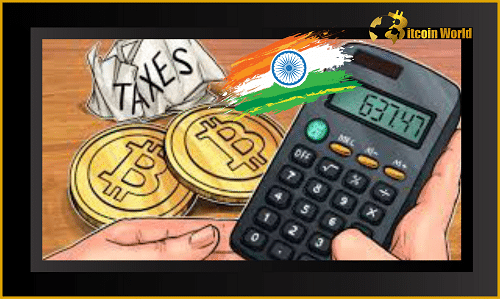Hold onto your hats, crypto enthusiasts! India’s Finance Minister, Nirmala Sitharaman, just dropped a bombshell in the crypto world. As of February 1, 2022, a 30% tax on income from cryptocurrencies and NFTs is now a reality in India. But is this a leap forward for crypto regulation or a heavy blow to Indian crypto investors? Let’s dive into the details and hear what the experts are saying.
What’s the Buzz About This 30% Crypto Tax?
Imagine this: you make a profit trading your favorite crypto coins, and suddenly, a third of it goes to taxes. That’s the reality many Indian crypto investors are facing with this new 30% levy. Some experts believe this tax is simply too high, potentially stifling the burgeoning crypto market in India. They argue that it feels like a significant chunk of your hard-earned crypto gains vanishing into thin air.
However, not everyone sees it as doom and gloom. Many crypto insiders view this 30% tax as a pivotal moment – a clear signal that the Indian government is finally acknowledging cryptocurrencies and NFTs as legitimate asset classes. This recognition, in itself, could be a huge win for the industry in the long run. But, is it a case of ‘one step forward, two steps back’ with such a high tax rate?
Decoding the 30% Tax Announcement
During her budget speech, Minister Sitharaman didn’t mince words. She announced a flat 30% tax on income from ‘digital assets,’ encompassing cryptocurrencies and the increasingly popular Non-Fungible Tokens (NFTs). Adding to the digital push, she also unveiled plans for India’s own digital rupee, powered by blockchain, slated to launch in 2022-23. This dual announcement has sent ripples through the Indian crypto space, sparking both excitement and concern.
Expert Reactions: Is it Good News or Bad News?
Let’s hear from some of the key players in the Indian crypto market to gauge their immediate reactions:
-
Nischal Shetty, Founder & CEO of WazirX: He sees the tax clarity as a major positive. According to Shetty, “The biggest development today was clarity on crypto taxation. This will add the much-needed recognition to the crypto ecosystem of India. We also hope this development removes any ambiguity for banks, and they can provide financial services to the crypto industry. Overall, it’s good news for us…”
-
Sumit Gupta, Co-founder & CEO of CoinDCX: Gupta echoes the sentiment of confidence. He stated that the 30% tax introduction “brings much-needed confidence to the industry” and is “a step in the right direction.”
-
Sharat Chandra, Crypto Evangelist: Taking a more critical stance, Chandra believes the 30% tax is a burden. He argues, “This move would force people to move to traditional modes of investment such as stock and mutual funds because they are not subject to as high as 30% tax.”
It’s clear that opinions are divided. While some industry leaders are optimistic about the recognition and clarity, others are worried about the impact of such a high tax rate on investor sentiment and market growth.
The 1% TDS Twist: Making Crypto Trading Trickier?
But wait, there’s more! Alongside the 30% income tax, Minister Sitharaman also introduced a 1% Tax Deducted at Source (TDS) on payments related to virtual asset purchases. This TDS is raising eyebrows and sparking concerns, particularly among active crypto traders.
Vishwanath, CEO of Unocoin, highlights this concern, stating, “There are multiple things here. Income tax at 30% is still acceptable but 1% TDS makes it tricky for intra-day traders in India.” The 1% TDS could add complexity and potentially reduce the profitability of frequent trading, especially for day traders who rely on small margins.
NFTs Under the Tax Lens: Disappointment for Some
The taxation net also extends to Non-Fungible Tokens (NFTs). Keyur Patel, Co-Founder and Chairman of GuardianLink and BeyondLife.Club, an NFT platform, expressed disappointment regarding NFT taxation. While the specifics of NFT taxation are still unfolding, the inclusion of NFTs under the 30% tax regime adds another layer to the evolving crypto tax landscape in India.
Key Takeaways: India’s 30% Crypto Tax – What Does it Mean for You?
Let’s break down the key implications of this new crypto tax policy:
- High Tax Rate: A flat 30% tax on crypto income is significant and could impact profitability, especially for frequent traders and smaller investors.
- Recognition of Crypto: The tax is a clear signal that the Indian government recognizes cryptocurrencies and NFTs as legitimate asset classes, which could pave the way for further regulatory clarity.
- 1% TDS Complexity: The 1% TDS adds a layer of complexity and potential friction to crypto transactions, particularly for day traders.
- Impact on Market: The long-term impact on the Indian crypto market remains to be seen. It could either encourage more regulated growth or potentially drive some investors away to other markets or traditional assets.
What’s Your Take?
The introduction of a 30% tax on crypto and NFT income is a landmark moment for the Indian crypto industry. It’s a complex issue with both potential benefits and drawbacks. What do you think about this move? Will it boost the legitimacy of crypto in India, or will it stifle innovation and investor participation? Share your thoughts and opinions in the comments section below!
Disclaimer: The information provided is not trading advice, Bitcoinworld.co.in holds no liability for any investments made based on the information provided on this page. We strongly recommend independent research and/or consultation with a qualified professional before making any investment decisions.


